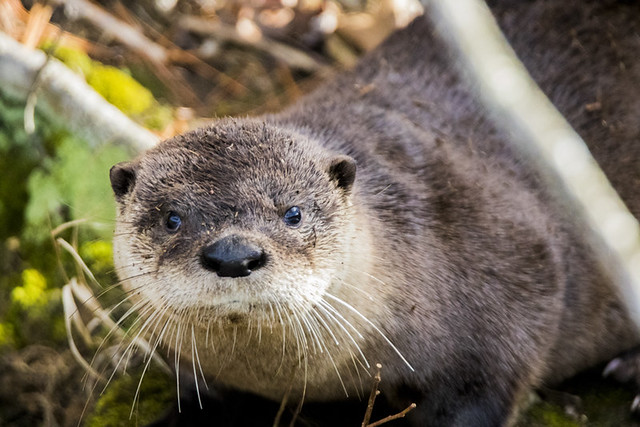Read Our Blogs
Otter Encounter at Fairy Stone
Shared by Glen Mitchell, as Guest Blogger.
I love to do wildlife photography from the kayak, and Fairy Stone Lake is one of my favorite places. It has abundant wildlife and a lot of shallow coves, which is a great environment to see birds, turtles, and other animals.
So my wife Susanna and I took the kayaks out for the first time this season in early February at Fairy Stone State Park. The weather was warm and though there was a skim of ice at the boat ramp, the water was calm and glasslike. A perfect day.
We were paddling down toward the dam when we saw a couple of brown heads making wakes in the water a good distance ahead. At first, we thought they were beavers, which we often see there. We soon realized that it was a pair of otters. They swam to shore and climbed out, allowing us to get a good look. Based on the size difference between the two, we assumed it was a mother and yearling. We were too far away to see exactly what they were doing, but they would walk around on the shore a for a minute, get back in the water, then swim to another spot farther down the bank and get out again. I managed to get a few shots but they soon went around a point and disappeared. We paddled on.
Susanna saw the larger one swimming along the shoreline again, and we watched as it swam out toward the middle of the lake and dove. We thought we had seen the last of it, but after a minute it came back to the surface, splashing around. Susanna looked through her field glasses and realized that it was eating a small fish. It dove many times, coming back up with fish several times. When it was underwater, we would paddle a little closer, trying to get a better look, not to mention photos. We worried about scaring it, but it didn’t seem to pay us any mind.
Otters play near the lake at Fairy Stone State Park in February
After a few minutes and a dozen dives it had apparently had its fill and started swimming back to shore. It climbed up on the bank and scampered up to the base of a large tree about 15 feet from shore. It went around the tree a couple of times, found a spot, and laid back against the tree and started grooming itself. Otters must groom often to make sure the fur is insulated and waterproof. It would scratch and rub its fur with its paws, sometimes using its snout and whiskers to comb the fur. It would stretch out, seeming to enjoy the sunshine as much as we were. While it was doing this, I slowly moved closer.
The otter kept an eye on me but didn’t seem to mind my being there. It would look at me for a second, then get back to preening. It seemed to be more curious than alarmed. I was close enough to get some great shots with the 150-600 lens I always use. After about 20 minutes, the otter got up and walked right toward me. It ambled down the bank, coming very close. I got a couple of final portraits as it slipped into the water, swam off to my left, and then went back to the middle for more fishing.
We decided we didn’t want to further disrupt its routine, so we moved on, happy from the experience. We had never gotten to watch otters like this, so this was a day we will always remember.
EDITOR'S NOTE
Did you know
- An otter's tail is called a rudder.
- There are 13 species of otters worldwide and are found on every continent except Australia and Antarctica.
- They are in the weasel family, which includes minks, ferrets, wolverines and badgers.
- River otters can hold their breath underwater for up to 5-8 minutes and dive as deep as 55 feet.
- Their diet is non-game fish, frogs, rodents, turtles, insects, crayfish and eggs
- Otters have the thickest fur of any animal in the world with up to a million hairs per square inch. That’s 10 times what we have on our whole head.
- Baby otters are called cubs, pups or kits. They are born in the spring and can live up to 15 years in the wild and 25 years in captivity.
- Otters love tobogganing in the snow or mud. They slide down on their bellies into the water, jump out, run to the top of the slide, and go again.
A few links to more fun information about otters:
If you have read the article and have a question, please email nancy.heltman@dcr.virginia.gov.
Search for blogs
By Park
Categories
Cabins
Camping
Fishing
History and Culture
Other
Programs and Events
Trails
Volunteers
Water Fun
Archive
2024
2023
2022
2021
2020
2019
2018
2017
2016
2015
2014
2012
















